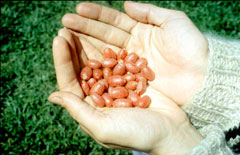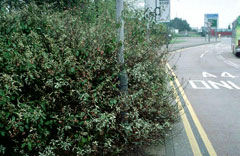 |
|
(c) 2010 Ken Fern & Plants For A Future |
 |
| (c) 2010 Ken Fern & Plants For A Future |
Translate this page:
Summary
Elaeagnus species
The family Elaeagnaceae contains several edible genera, including Silverberry (Elaeagnus), Buckthorn (Hippophae) and Buffaloberry (Shepherdia). All the species are nitrogen fixers, having a symbiotic relationship with soil bacteria, making them excellent companion plants. Growing with fruit trees can increase yields by up to 10% (especially with plums and nuts, which respond more to nitrogenous fertilisation). The fruit of many family members is a rich source of vitamins and minerals (especially vitamins A, C and E), flavonoids and other bioactive compounds. It is also a good source of essential fatty acids, which is unusual for a fruit.
Elaeagnus are deciduous or evergreen shrubs or small trees, with simple, often silvery-scaled leaves and small fragrant tubular flowers followed by small juicy fruit edible in many species. They usually require some shade. Evergreen species are early fruiting plants, with fruit ripening over 6-8 weeks in early to late spring. Eat the fruit raw or cooked in soups, jellies or sherbets. The deciduous species fruit during the summer and need a sunny position. Ebbinge’s Silverberry (E. x ebbingei) is the best evergreen species. The fruits must be fully ripe and have a lovely, rich taste reminiscent of pineapple. They are 25mm (1in) long with a large edible seed high in protein and fats. The seed has a mild flavour with a hint of peanut.
Physical Characteristics

 Elaeagnus x ebbingei is an evergreen Shrub growing to 5 m (16ft) by 5 m (16ft) at a fast rate.
Elaeagnus x ebbingei is an evergreen Shrub growing to 5 m (16ft) by 5 m (16ft) at a fast rate.
See above for USDA hardiness. It is hardy to UK zone 6 and is not frost tender. It is in leaf all year, in flower from October to January, and the seeds ripen from April to May. The species is hermaphrodite (has both male and female organs) and is pollinated by Bees. The plant is self-fertile.
It can fix Nitrogen.
It is noted for attracting wildlife.
Suitable for: light (sandy), medium (loamy) and heavy (clay) soils, prefers well-drained soil and can grow in nutritionally poor soil. Suitable pH: mildly acid, neutral and basic (mildly alkaline) soils. It can grow in full shade (deep woodland) semi-shade (light woodland) or no shade. It prefers dry or moist soil and can tolerate drought. The plant can tolerate maritime exposure.
UK Hardiness Map
US Hardiness Map
Synonyms
Plant Habitats
Woodland Garden Sunny Edge; Dappled Shade; Shady Edge; not Deep Shade; Hedge; North Wall. In. East Wall. In. South Wall. In. West Wall. In.
Edible Uses
Edible Parts: Fruit Seed
Edible Uses:
Fruit - raw or cooked[177]. A reasonable size, it is about 20mm long and 13mm wide although it does have a large seed[K]. The fully ripe fruit has a very rich flavour and makes pleasant tasting with a slight acidity[K]. The fruit should be deep red in colour and very soft when it is fully ripe, otherwise it will be astringent[K]. The flavour improves further if the fruit is stored for a day or two after being picked. The fruit ripens intermittently over a period of about 6 weeks from early to mid April until May[K]. Seed - raw or cooked. It can be eaten with the fruit though the seed case is rather fibrous[K]. The taste is vaguely like peanuts[K].
References More on Edible Uses
Medicinal Uses
Plants For A Future can not take any responsibility for any adverse effects from the use of plants. Always seek advice from a professional before using a plant medicinally.
Cancer
The fruit of many members of this genus is a very rich source of vitamins and minerals, especially in vitamins A, C and E, flavanoids and other bio-active compounds. It is also a fairly good source of essential fatty acids, which is fairly unusual for a fruit. It is being investigated as a food that is capable of reducing the incidence of cancer and also as a means of halting or reversing the growth of cancers[214].
References More on Medicinal Uses
The Bookshop: Edible Plant Books
Our Latest books on Perennial Plants For Food Forests and Permaculture Gardens in paperback or digital formats.

Edible Tropical Plants
Food Forest Plants for Hotter Conditions: 250+ Plants For Tropical Food Forests & Permaculture Gardens.
More

Edible Temperate Plants
Plants for Your Food Forest: 500 Plants for Temperate Food Forests & Permaculture Gardens.
More

More Books
PFAF have eight books available in paperback and digital formats. Browse the shop for more information.
Shop Now
Other Uses
Companion Hedge Hedge
Agroforestry uses: Elaeagnus species can be used as a hedge or windbreak due to their dense growth and thorny branches. They also improve soil fertility as nitrogen-fixing plants, making them beneficial in agroforestry systems. Their fruits provide food for wildlife and can be harvested for human consumption. Plants can be grown as a hedge in very exposed positions, tolerating maritime exposure. The plants provide very good protection from the wind, are very resistant to damage by salt winds, and are also tolerant of regular trimming[75]. They have a strong, vigorous growth and are faster growing than E. macrophylla[75, 200]. Because they fix atmospheric nitrogen, they make good companion plants and improve the growth of neighbouring species[K]. They can be planted in the line of an old shelterbelt of trees that is becoming bare at the base and will in time fill up the empty spaces and climb into the bottom parts of the trees[K]. Fruits from Elaeagnus species are usually harvested in late summer to early autumn, depending on the species and local climate.
Elaeagnus species generally flower in late spring to early summer, depending on the specific species and environmental conditions.
Special Uses
Food Forest Hedge Hedge Nitrogen Fixer Scented Plants
References More on Other Uses
Cultivation details
A very easily grown plant, it succeeds in most soils that are well-drained[11, 200]. Prefers a soil that is only moderately fertile, succeeding in poor soils and in dry soils[11, 200]. A drought resistant plant once established, it can be grown on top of Cornish hedges (drystone walls with earth between two vertical layers of stones). It is very tolerant of shade and grows well under trees[200]. Plants are very tolerant of maritime exposure, growing well right by the coast[K]. Plants are hardy to about -20°c, but they can be deciduous in very cold winters[200]. Fruiting as it does in early April to May, this plant has excellent potential as a commercial fruit crop in Britain. The fruit is of a reasonable size and when fully ripe is very acceptable for dessert[K]. It should be fairly easy to selectively breed for improved fruit size and flavour[K]. Not all plants bear many fruits, though many specimens have been seen that produce very heavy crops on a regular basis[K]. Since this is a hybrid species, yields may be improved by growing a selection of cultivars or one of the parent plants nearby for cross pollination. E. pungens is perhaps the best candidate for this and its cultivar E. pungens 'Variegata' has been seen on a number of occasions with good crops of fruit next to E. x ebbingei plants that are also laden with fruit[K]. The cultivar E. x ebbingei 'Gilt Edge' is also probably a good pollinator[K]. Other cultivars worth looking at are 'Salcombe Seedling', which is said to flower more abundantly than the type[200] and 'Limelight', which has been seen with a good crop of fruits even on small bushes[K]. This species has a symbiotic relationship with certain soil bacteria, these bacteria form nodules on the roots and fix atmospheric nitrogen. Some of this nitrogen is utilized by the growing plant but some can also be used by other plants growing nearby[200]. An excellent companion plant, when grown in orchards it can increase yields from the fruit trees by up to 10%. Plants produce very aromatic flowers in late autumn and early winter[182]. This species is notably resistant to honey fungus[88, 200]. Sometimes whole branches die out for no apparent reason. This happens most frequently when it is grafted onto E. multiflora[182]. These branches should be removed from the plant. In garden design, as well as the above-ground architecture of a plant, root structure considerations help in choosing plants that work together for their optimal soil requirements including nutrients and water. The root pattern is branching: a heart root, dividing from the crown into several primary roots going down and out [2-1]. Elaeagnus species are relatively fast-growing shrubs or small trees, typically reaching maturity in 3 to 5 years. They can grow to heights of 1 to 5 meters (3 to 16 feet) depending on the species and growing conditions. Fruits from Elaeagnus species are usually harvested in late summer to early autumn, depending on the species and local climate.
Elaeagnus species generally flower in late spring to early summer depending on the specific species and environmental conditions.
Many Elaeagnus species are self-fertile, meaning they can produce fruit without needing another plant for cross-pollination.
References Carbon Farming Information and Carbon Sequestration Information
Temperature Converter
Type a value in the Celsius field to convert the value to Fahrenheit:
Fahrenheit:
The PFAF Bookshop
Plants For A Future have a number of books available in paperback and digital form. Book titles include Edible Plants, Edible Perennials, Edible Trees,Edible Shrubs, Woodland Gardening, and Temperate Food Forest Plants. Our new book is Food Forest Plants For Hotter Conditions (Tropical and Sub-Tropical).
Shop Now
Plant Propagation
Seed - this is a hybrid and it will not breed true from seed. If this is not a problem, then the seed is best sown as soon as it is ripe in a cold frame[78]. It should germinate freely within 4 weeks, though it may take 18 months[K]. Stored seed can be very slow to germinate, often taking more than 18 months. A warm stratification for 4 weeks followed by 12 weeks cold stratification can help[98]. The seed usually (eventually) germinates quite well[78]. Prick out the seedlings into individual pot as soon as they are large enough to handle and plant out when they are at least 15cm tall. Cuttings of half-ripe wood, 7 - 10cm with a heel, July/August in a frame. Rather slow, but you usually get a good percentage rooting[78]. June is the best time to take cuttings[202]. Cuttings of mature wood of the current year's growth, 10 - 12cm with a heel, November in a frame. Leave for 12 months. Fair to good percentage[78]. Layering in September/October. Takes 12 months[78].
Other Names
If available other names are mentioned here
Native Range
Australia,
Weed Potential
Right plant wrong place. We are currently updating this section.
Please note that a plant may be invasive in one area but may not in your area so it's worth checking.
Conservation Status
IUCN Red List of Threatened Plants Status :

Growth: S = slow M = medium F = fast. Soil: L = light (sandy) M = medium H = heavy (clay). pH: A = acid N = neutral B = basic (alkaline). Shade: F = full shade S = semi-shade N = no shade. Moisture: D = dry M = Moist We = wet Wa = water.
Now available:
Food Forest Plants for Mediterranean Conditions
350+ Perennial Plants For Mediterranean and Drier Food Forests and Permaculture Gardens.
[Paperback and eBook]
This is the third in Plants For A Future's series of plant guides for food forests tailored to
specific climate zones. Following volumes on temperate and tropical ecosystems, this book focuses
on species suited to Mediterranean conditions—regions with hot, dry summers and cool, wet winters,
often facing the added challenge of climate change.
Read More
Expert comment
Author
Boom.
Botanical References
11200
Links / References
For a list of references used on this page please go here
Readers comment